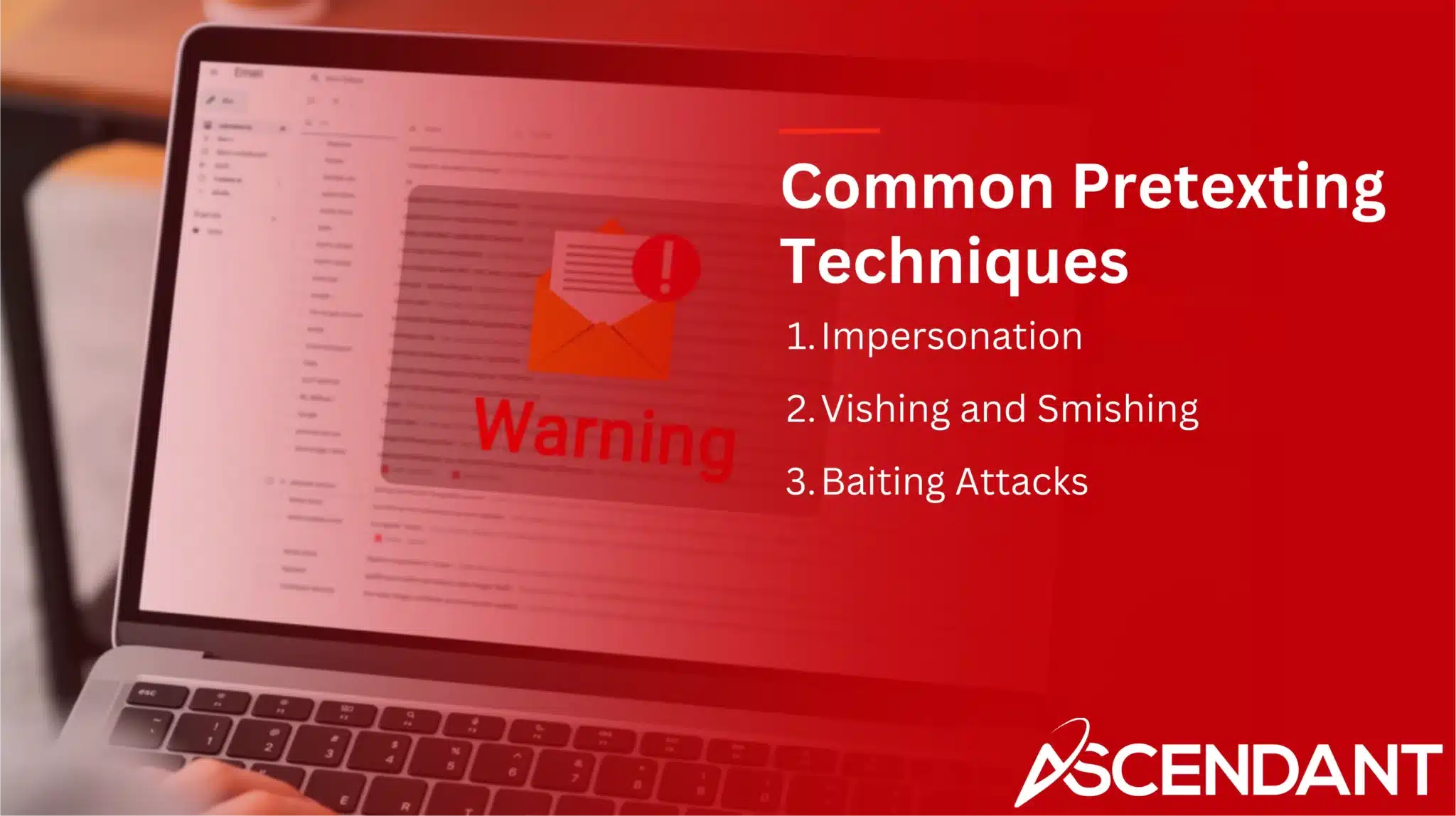Pretexting is a social engineering tactic where attackers deceive individuals to gain sensitive information by creating believable but false scenarios. This article will explain what pretexting is, show how these attacks work, discuss common techniques, and provide tips on how to protect yourself and your organization.
In This Article:
- What is Pretexting?
- How Pretexting Works
- Common Pretexting Techniques
- Real-World Examples of Pretexting Attacks
- Differences Between Pretexting and Phishing
- Legal and Ethical Implications of Pretexting
- How to Prevent Pretexting Attacks
- Impact of Pretexting on Organizations
- Future Trends in Pretexting
Key Takeaways
- Pretexting is a social engineering attack that manipulates individuals into disclosing sensitive information by fabricating believable scenarios.
- Common techniques include impersonation, vishing, smishing, and baiting, which exploit trust and urgency to deceive victims.
- To prevent pretexting, organizations should implement security awareness training, strict verification processes, and continuous monitoring of user behaviors.
What is Pretexting?
Pretexting involves creating fictitious but plausible situations to deceive individuals into revealing private information. By exploiting the tendencies of human psychology, this approach to social engineering convinces people to divulge sensitive details because they are more apt to respond affirmatively when dealing with supposed authority figures or urgent matters—attributes that make them susceptible targets for pretexting scams.
To bolster their authenticity, perpetrators employ a range of social engineering strategies such as impersonating IT support staff or high-level company officials. They might also leverage AI technology to develop highly persuasive pretexts that closely simulate authentic interactions, thereby enhancing the effectiveness of their social engineering attacks.
Scenarios in pretexting could encompass receiving calls from someone posing as a bank official or getting emails purportedly sent by a co-worker. These circumstances are carefully constructed with the intent of fostering trust and projecting an image of legitimacy.
How Pretexting Works
Pretexting attacks exploit trust and deception by attackers assuming the roles of authority figures or individuals who are Trusted, compelling their targets to comply. These attackers craft believable situations that entice victims into divulging confidential data. To successfully impersonate a trusted entity, they must execute detailed preparation and conduct in-depth research on the target to establish credibility.
These scammers create trust through well-constructed narratives adorned with recognizable logos or using familiar means of communication. They utilize collected personal details to lend more legitimacy to their deceptive requests, sometimes inducing feelings of urgency or fear to provoke rash decisions from the victim. Advances in AI technology now equip modern pretexters with tools for creating even more authentic-seeming dialogues and plots, which makes these schemes increasingly difficult to recognize.
Common Pretexting Techniques
Pretexting encompasses various techniques designed to deceive and manipulate targets, including pretexting scam methods such as impersonation, vishing and smishing, and baiting attacks.
Recognizing these techniques will help you better defend against pretexting scenarios.
Impersonation
Pretending to be someone they’re not, attackers often employ the tactic of impersonation as a pretexting strategy with the goal of obtaining sensitive information. By manipulating caller ID or email details, these individuals craft a façade of legitimacy that boosts their chances of persuading their target to fulfill their requests. For instance, by assuming the role of a company CEO, an attacker could deceive an employee into revealing confidential data.
Leveraging elements such as trust and authority inherent in human psychology is central to this form of social engineering. Attackers who convincingly adopt identities as superiors or familiar peers are adept at coaxing out private information from unsuspecting victims. Their effectiveness is amplified when they weave in personal knowledge about those they prey upon and communicate through channels that lend themselves to authenticity.
Vishing and Smishing
Voice phishing, also known as vishing, is the practice of making phone calls to trick individuals into disclosing sensitive information. The perpetrators often impersonate representatives from banks or government bodies in an attempt to secure personal details. One typical strategy involves posing as a representative from the IRS with the intent of acquiring access to someone’s financial data.
In contrast, smishing relies on text messages to deceive people into giving up sensitive information. These texts may include links leading to harmful websites or ask for private information in a manner similar to various phishing efforts and a singular phishing scam.
Both vishing and smishing leverage the directness and perceived intimacy associated with phone calls and SMS communication. This tactic increases their success rate by prompting recipients to respond impulsively due partly because they might perceive these methods as trustworthy means of contact.
Baiting Attacks
Attackers utilizing baiting strategies tempt individuals by promising enticing incentives like complimentary software downloads or privileged content, with the intention of dispersing malware or extracting sensitive data. To entice potential targets, they might strategically plant flash drives contaminated with malware or craft alluring propositions and place them in areas frequented by the public such as building entrances or transportation hubs.
Leveraging people’s natural inclination towards curiosity and their attraction to freebies or exclusives is central to these schemes. When victims are drawn into the trap, they may inadvertently imperil their own security either through permitting access to their systems unknowingly or divulging sensitive details to those orchestrating the attack.
Real-World Examples of Pretexting Attacks
In 2006, Hewlett-Packard was embroiled in controversy when investigators were found impersonating board members to illicitly acquire phone records, casting a spotlight on the grave legal and moral issues involved. Fast forward to 2020, Twitter became the victim of an incursion where cybercriminals combined hacking with pretexting techniques to hijack employee credentials and seize control of prominent accounts resulting in significant disturbances.
Additional instances that stand out include Ubiquiti Networks’ encounter with fraudsters in 2015 who deceived $46.7 million through counterfeit payment requests and Quanta Computer’s experience being swindled out of more than $100 million by individuals masquerading as representatives from within the company. These incidents reflect the multifaceted nature and substantial impact that can arise from pretexting attacks.
Pretexting is also commonly employed in schemes such as tech support cons, deceptive job offers, and insincere romantic propositions. In tech support scams, perpetrators pretend to be agents of reputable organizations aiming to secure remote access into unsuspecting users’ computers. Whereas fake employment opportunities often involve paying for nonexistent training or background checks. Meanwhile romance scams involve creating artificial online personas only then entice their targets into providing financial aid based on fabricated stories or emergencies.
Differences Between Pretexting and Phishing
Pretexting and phishing both constitute types of social engineering attacks, yet they diverge in their execution methods. Pretexting involves the use of complex impersonations designed to build trust and influence the target’s emotional responses. On the other hand, phishing is known for its reliance on creating a sense of urgency or instilling fear, employing more direct means to extract sensitive information.
While phishing attacks frequently take place through emails or text messages seeking immediate action from victims, pretexting employs intricate fabricated stories aimed at obtaining private data. The former tends to require substantial preparation and utilizes psychological tactics to enhance authenticity. Meanwhile, the latter may often resort to using counterfeit email addresses or phone numbers that appear as though they belong to legitimate entities.
Legal and Ethical Implications of Pretexting
In the United States, it is against the law to engage in pretexting due to its substantial legal dangers for both individuals and entities that partake in it. The act of acquiring financial data via deceptive practices is forbidden by the Gramm-Leach-Bliley Act, while procuring telephone records without authorization through pretexting is a criminal offense under the Telephone Records and Privacy Protection Act.
Entities implicated in pretexting might encounter regulatory examination as well as monetary penalties under regulations like GDPR and CCPA. Pretexting not only leads to legal repercussions but also breaches ethical principles since it infringes on laws designed to safeguard personal privacy and information security.
How to Prevent Pretexting Attacks
Grasping how pretexting operates is key to recognizing and reducing possible dangers. To prevent attacks that use false pretexts, emphasis should be placed on training for security awareness, processes for verification, as well as monitoring and detection activities.
Security Awareness Training
Workers ought to be educated in identifying cultural and environmental signals that could signal pretexting activities. Such training should encompass methods for scrutinizing requests for information that appear unusual, as well as comprehending the significance of safeguarding sensitive data from being disclosed.
Incorporating real-world scenarios and practice drills can improve the staff’s proficiency in detecting and countering attempts at pretexting. Consistently providing security alerts along with updates concerning emerging social engineering strategies will aid in keeping employees alert.
Verification Processes
To protect sensitive data from unauthorized access, it is vital for organizations to enforce stringent verification procedures. When requests for sensitive information arise, utilizing callback techniques to confirm identities can help secure this data. Creating particular verification questions that relate directly to the sensitive information can strengthen these security measures even more. By taking these steps, organizations limit access to sensitive information exclusively to those with proper authorization, thereby diminishing the threat of pretexting attacks.
Monitoring and Detection
Behavioral analytics geared toward user activities can pinpoint atypical access behaviors suggestive of pretexting. By setting up instantaneous notifications for anomalous actions, organizations are equipped to act swiftly in the face of possible threats.
It’s crucial to have monitoring tools in place for spotting dubious activities and thwarting potential attempts at pretexting. The ongoing vigilance over systems and networks allows companies to detect and lessen risks prior to any substantial damage being inflicted.
Impact of Pretexting on Organizations
If a pretexting attack leads to the compromise of sensitive information, organizations could be subjected to substantial penalties and legal issues. Financial losses due to theft as well as expenses related to recovery measures are included in these economic repercussions.
Pretexting-related data breaches can inflict considerable monetary damage and have enduring consequences on a company’s standing. Such incidents may deeply erode trust in customer data security, potentially affecting both revenue and the organization’s position within the market.
Future Trends in Pretexting
The development of artificial intelligence and deepfake technology has given attackers new tools to craft convincing impersonations, elevating the effectiveness of social engineering. These technological advancements contribute to the sophistication of pretexting attacks, increasing their difficulty in detection and defense.
As threat actors adapt their strategies with evolving technologies, keeping abreast of these changes and regularly enhancing security measures will be essential for thwarting future pretexting attacks.
Summary
Pretexting is a sophisticated and dangerous form of social engineering that exploits human psychology and trust. By understanding the mechanics of pretexting, recognizing common techniques, and implementing strong security measures, individuals and organizations can better defend against these attacks. Stay vigilant and proactive in protecting your sensitive information from pretexting scams.
 Frequently Asked Questions
Frequently Asked Questions
What is pretexting in cyber security?
Pretexting is a type of social engineering technique in which an attacker devises a plausible situation to trick individuals into disclosing sensitive information or providing access to secure areas.
Such deceptive tactics can cause people or institutions to inadvertently breach their own security protocols.
What is the difference between impersonation and pretexting?
Impersonation necessitates thorough investigation to credibly assume the persona of another person, whereas pretexting depends on concocting a false situation to interact with the target without necessarily imitating someone.
Thus, the fundamental difference is in their methods: impersonation requires more profound understanding and information gathering, while pretexting employs an invented story.
What is another word for pretexting?
Another word for pretexting is “excuse,” as it implies offering false reasons or motives to justify actions.
How does pretexting differ from phishing?
Pretexting sets itself apart from phishing by employing intricate impersonations and complex situations to build trust, while phishing commonly uses tactics of urgency and fear through emails or texts to acquire sensitive information.
What are common pretexting techniques?
Impersonation, vishing (voice phishing), smishing (SMS phishing), and baiting are typical pretexting strategies used to abuse trust and coax individuals into disclosing sensitive information through deceptive means.


